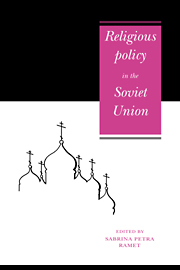Book contents
- Frontmatter
- Contents
- Notes on contributors
- Preface
- Part I Introduction
- Part II Policy apparatus
- Part III Education, socialisation, and values
- Part IV Cults and sects
- 10 Dilemmas of the spirit: religion and atheism in the Yakut-Sakha Republic
- 11 The spread of modern cults in the USSR
- Part V The world of Christianity
- APPENDIX: Religious groups numbering 2,000 or more, in the USSR
- Index
11 - The spread of modern cults in the USSR
Published online by Cambridge University Press: 03 December 2009
- Frontmatter
- Contents
- Notes on contributors
- Preface
- Part I Introduction
- Part II Policy apparatus
- Part III Education, socialisation, and values
- Part IV Cults and sects
- 10 Dilemmas of the spirit: religion and atheism in the Yakut-Sakha Republic
- 11 The spread of modern cults in the USSR
- Part V The world of Christianity
- APPENDIX: Religious groups numbering 2,000 or more, in the USSR
- Index
Summary
The spread of modern cults in the Soviet Union is – in the same way as is the continued existence of the official churches – a convincing proof that the regime did not succeed in extinguishing Soviet people's faith in God. In the face of the extensive system of scientific–atheist propaganda which was systematically conducted in the Soviet Union on a far-reaching scale, the spreading of new religious teachings was a heavy blow to ideological education, since atheist propaganda was one of its most important components. This propaganda was supposed to influence Soviet people from kindergarten to the grave with the aim of freeing them from all ‘religious remnants’. To reach this aim, mass persecution of all churches and believers was started immediately after the Bolsheviks came to power in Russia. The official churches – Christian as well as the non-Christian – were subject to heavy persecution, along with the numerous sects which had existed in Tsarist Russia (the Baptists, the Seventh Day Adventists, the Mennonites, the Dukhobors, the Molokans, and others). By the eve of the Second World War, practically all the religious organisations had been destroyed, and the church as an institution had been forced out of public life. Statistics of that time indicate that the Russian Orthodox Church had been reduced to a tiny proportion of its pre-revolutionary strength. The situation of the Russian Orthodox Church and other churches as well changed positively only after Josef Stalin received the hierarchs of the Russian Orthodox Church in September 1943, at the height of combat action, and concluded a kind of concordat with them.
- Type
- Chapter
- Information
- Religious Policy in the Soviet Union , pp. 252 - 270Publisher: Cambridge University PressPrint publication year: 1992

